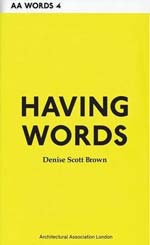
|

|
|
Home Site Search Contact Us Subscribe
|
|
|
Book Review: Sage Architectural Reflections from Architecture's "Athena": Denise Scott Brown's "Having Words" distills a lifetime of theorizing and practice into practical and succinct guidance for thriving through difficult times Brown's occasional papers trace a trenchant trajectory of learning from Las Vegas to learning from everything. By Norman Weinstein April 27, 2010 A blessing accruing from many major architects having long lives is that they might get to enjoy the widespread acceptance and acclaim that was deserved in mid-life. Denise Scott Brown is an excellent case in point. After a recent ovation at Yale, and following critic Martin Filler’s New York Review of Book polemic as to why Brown, rather than Zaha Hadid, is the great woman architect of our time, Brown’s stature is finally approaching well-deserved Athena-like grandeur. Athena, let it be remembered, was the Greek divine symbol for feminine strength, strategy, and craft. Also notable was Athena’s uncanny ability to successfully collaborate with talented men.
But bringing an all-so-human scale to Brown, London’s Architectural Association published a miscellany of her brief essays, really a handful of occasional papers written between 1969 and 2007. Brown characterizes Having Words as “cheap enough to be available to students and young architects and easily readable on the bus or in bed.” Don’t let packaging deceive. This is potent and deep material for all architects.
The book’s title can be read two ways. “Having words” can mean asserting one’s authority in the face of misrepresentation. And “having words” can also mean having them in one’s attention as a versatile and persuasive tool, and these essays cogently span both meanings of the phrase. Brown’s assertion of authority is particularly poignant in “Sexism and the Star System” in which she defines her original sensibility and contributions within the context of her decades-long design collaboration with her husband, Robert Venturi. Yet her writing about her wounds caused by sexism, prejudice made acute by uninformed journalists repeatedly favoring her husband as the center of their partnership, never dissolves into self-pitying diatribe, and concludes positively:
Over the years, it has slowly dawned on me that the people who cause my painful experiences are ignorant and crude. . . .I have been helped to realize this by noticing that the scholars whose work we most respect, the clients whose projects most intrigue us, and the patrons whose friendship inspires us, have no problem understanding my role.
Integral to her singularly crucial role within the Philadelphia-based firm of Venturi, Scott Brown & Associates has been her particular sensitivity to vernacular design as filtered through her youth in South Africa and Europe, and most crucially, her thorough grounding in linking design to a sociologically-sensitive vision of urban planning, Her insistences regarding the inextricability of top-drawer urban planning and design are particularly welcome in 2010. In this theory-laden time of contending “isms” among young architects and their teachers, in this vertiginous global economic and ecological climate, in this time of high-tech bacchanalia, Brown’s steady eye as urban planner-architect is stabilizing and inspiring.
In the last chapter, with typical charm, she considers her lifetime contribution:
. . . I have come to feel like architecture’s grandmother, a guardian of its institutional memory, who knows the pitfalls and where the bodies are buried . . .
But then she returns to the less dowdy, more magisterial role of architecture’s Athena:
What should we architects do when our brightest world leaders want to use challenge as opportunity? This can be an exciting time if we remember that smaller budgets call for greater imagination and tackling hard problems can produce brave architecture. Rekindling our 1960s concern for poverty and learning to use government effectively . . . are other challenges. So too is defining architecture as a wider window on a broader world than we had thought – but bringing to it well-honed skills, not rhetoric.
These are sage words well worth having.
Norman Weinstein writes about architecture and design for Architectural Record and The Christian Science Monitor, and is the author of “Words That Build” – an exclusive 21-part series published by ArchNewsNow.com – that focuses on the overlooked foundations of architecture: oral and written communication. He consults with architects and engineers interested in communicating more profitably. You can reach him at nweinste@mindspring.com.
More by Weinstein:
Op-Ed: Life After Ada: Reassessing the Utility of
Architectural Criticism
Book Review: Keeping
the Architectural Profession Professional: "Architecture from the Outside
In: Selected Essays by Robert Gutman" celebrates Gutman's legacy as
invaluable outsider
Book Review:
"Design through Dialogue: A Guide for Clients and Architects," by
Karen A. Franck and Teresa von Sommaruga Howard
Twilight Visions: Vintage Surrealist Photography Sheds
New Light on Architecture
Best
Architecture Books of 2009
Book Review: "Gunnar Birkerts: Metaphoric Modernist" by Sven Birkerts and Martin Schwartz A major architect in the history of Modernism finally receives recognition – and sundry asides about why Modernism never exited.
Book Review:
"Urban Design for an Urban Century: Placemaking for People," by Lance
Jay Brown, David Dixon, and Oliver Gillham
Book Review:
"Everything Must Move: 15 Years at Rice School of Architecture
1994-2009"
Book Review: A Subversive Book Every Architect Needs:
"Architect's Essentials of Negotiation" by Ava J. Abramowitz
Book Review: A Perspective from One Elevation: "Conversations With Frank Gehry" by Barbara Isenberg Gehry's conversations offer portraits of an astute listener as well as talker, an architect as aware of his flaws and limitations as of his virtues.
Best Architecture Books of 2008
Book Review: You've Got to Draw the Line Somewhere A review of Drafting Culture: a Social History of Architectural Graphic Standards by George Barnett Johnston
Book Review: "NeoHooDoo: Art for a Forgotten Faith," edited by Franklin Sirmans Sharpen your pencils - and get ready to do a NeoHooDoo shimmy. |
(click on pictures to enlarge) 
|
© 2010 ArchNewsNow.com